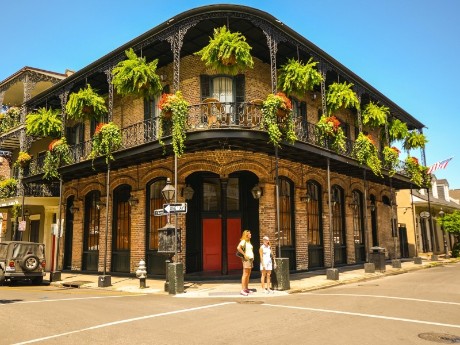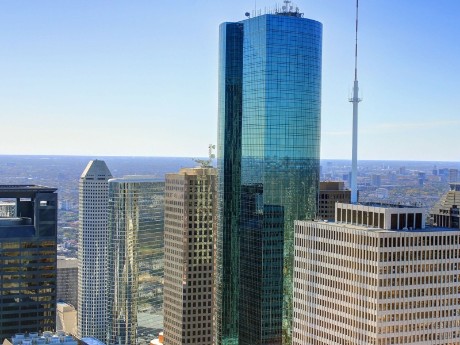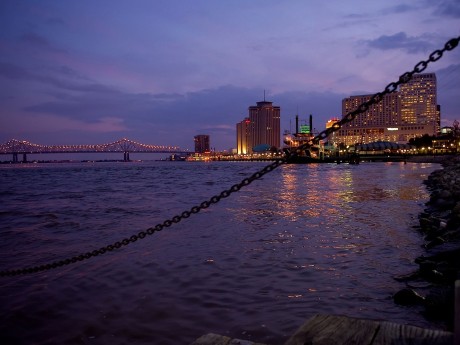USA: New Orleans & Houston
Embark on a captivating journey from the soulful streets of New Orleans to the vibrant heart of Houston. Begin your adventure in New Orleans, where the enchanting French Quarter, lively jazz music, and delectable Creole cuisine await. Marvel at the historic St. Louis Cathedral and enjoy a scenic steamboat cruise on the Mississippi River. Wander through the bustling streets of the French Market, a haven for unique crafts and local delicacies.
Read more
Embark on a captivating journey from the soulful streets of New Orleans to the vibrant heart of Houston. Begin your adventure in New Orleans, where the enchanting French Quarter, lively jazz music, and delectable Creole cuisine await. Marvel at the historic St. Louis Cathedral and enjoy a scenic steamboat cruise on the Mississippi River. Wander through the bustling streets of the French Market, a haven for unique crafts and local delicacies. Continue to Houston, a city brimming with cultural wonders. Explore the awe-inspiring Space Center Houston and immerse yourself in space exploration. Discover the Museum District, home to the Houston Museum of Natural Science and the Museum of Fine Arts. Stroll through Hermann Park, offering serene landscapes and water features, or take a walk along Buffalo Bayou, perfect for kayaking and biking. Savour Houston’s diverse culinary delights, from Tex-Mex to international cuisine. This trip blends history, culture, and modern marvels for a memorable experience from start to finish. Waterviews strives to offer accommodation options within walking distance of water and/or in an area of touristic interest. Our prices include taxes (but exclude local tourist taxes). Customize your trip to your personal preferences with optional activities (hit the “Add Activities’’) or change hotels, etc. Contact us for customization at no extra cost at: Service@waterviewstravel.com
Destinations
- New Orleans
- Houston
Itinerary
New Orleans

The cradle of jazz, iconic New Orleans lies on the edge of the sea in southern Louisiana. The city is bursting with culture and music, luring and seducing its visitors with its unique feel and authentic hospitality. With African-American as well as French and Spanish influences, New Orleans is a laid-back yet energetic city with the charm of a small town, and visitors will carry the city in their hearts for a long time to come.
Read more
The cradle of jazz, iconic New Orleans lies on the edge of the sea in southern Louisiana. The city is bursting with culture and music, luring and seducing its visitors with its unique feel and authentic hospitality. With African-American as well as French and Spanish influences, New Orleans is a laid-back yet energetic city with the charm of a small town, and visitors will carry the city in their hearts for a long time to come.
Additional Information
Overview
New Orleans is known for a host of attributes like its famous Creole food, abundant alcohol, music of many styles, nearby swamps and plantations, 18th- & 19th-century architecture, antiques, gay pride, streetcars, and museums. Nicknamed the Big Easy, New Orleans has long had a reputation as an adult-oriented city. However, the city also offers many attractions for families with children and those interested in culture and the arts. It is a city with Roman Catholic plurality owing to its French and Spanish origins.
Famous festivals like Mardi Gras and Jazz Fest bring in tourists by the millions, and are the two times of the year when you must book well in advance to be sure of a room. The city also hosts many smaller festivals and gatherings like the French Quarter Festival, Creole Tomato Festival, Satchmo SummerFest, the Essence Festival hosted by the magazine, Halloween parading and costume balls, Saint Patrick's Day and Saint Joseph's Day parading, and Southern Decadence. The city takes almost any occasion for an excuse for a parade, a party, and live music, and in New Orleans most events often have a touch of Mardi Gras year round. Like they say, New Orleanians are either planning a party, enjoying one or recovering from one. Party down!
It is a city of great culture with a clash of French, Cajun and some Spanish designs. You may see some voodoo activity at night. The streetcar rides are fun and many of the stores carry exclusive cultural art such as the blue dog collection.
History
In the late 1600s, French trappers and traders began settling in what is now New Orleans, along a Native American trade route between the Mississippi River and Lake Pontchartrain via Bayou St. John. In 1718 the city was founded as "Nouvelle-Orléans" by Jean-Baptiste Le Moyne de Bienville, Governor of the French colony of Louisiana, with the intent to build it into a provincial capital city. The early French city grew within the grid of what is now the French Quarter. Louisiana was transferred to Spanish rule in the 1760s, but much of the population retained French language and culture. After briefly returning to French rule, Louisiana was purchased by the United States in 1803. At first the new "American" settlers mostly built their homes and shops upriver from the older French parts of the city, across wide "Canal Street" (named for a planned canal that was never built). Canal Street was the dividing line between the Anglophone and Francophone sections; the street's wide median became a popular meeting place called "the neutral ground"—and "neutral ground" became the common phrase for the median of any street, still in use in the New Orleans dialect today.
A British attempt to seize the city in 1815 was repelled downriver from the city in Chalmette by local forces led by Andrew Jackson, whose equestrian statue can be seen in the square named after him in the center of the old Quarter.
Early New Orleans was already a rich melting pot of peoples and cultures. French Spanish African and Anglos were joined by immigrants from Ireland, Germany, and the Caribbean. While a center of the slave trade before the American Civil War, New Orleans also had the USA's largest population of free people of color. The city grew rapidly as a major trade center on the mighty Mississippi River. In the American Civil War of the 1860s, New Orleans fell to the Union early in the conflict without battle within the city, sparing the city's rich historic architecture from the destruction suffered by much of the American South.
At the start of the 20th century, the then largely neglected old French Quarter started gaining new appreciation among artists and bohemians for its architecture and ambiance. Around the same time, a new musical style developed in the city; the music developed and swept around the world under the name of "jazz".
Although far from the big battlefronts, New Orleans is proud of its contributions to the Allied victory over Fascism in World War II, especially the development and construction of landing craft such as "Higgins Boats" which made rapid landing masses of troops on hostile beaches possible. This legacy is why America's National World War II Museum is located in the city.
Hurricane Katrina and its aftermath
In August 2005 New Orleans and the surrounding area was hit by Hurricane Katrina. Much worse than the hurricane was the failure of the federally designed levee system; in what has been called "the worst civil engineering disaster in U.S. history" when some 80% of the city flooded.
New Orleans was not destroyed, but the flood was a severe blow, perhaps the worst disaster to hit a U.S. city since the great San Francisco earthquake 99 years previous. A decade later, many visitors might notice little or no sign that anything bad happened. For locals, however, rebuilding is still an ongoing process. The French Quarter and other oldest parts of town most popular with visitors were built on comparatively high ground, and were less damaged and have been more quickly restored. However, not everything is back to normal in the city; scenes of devastation can be still seen in many neighborhoods. More than two-thirds of the city's pre-Katrina population is back living in the city; most of them have a fierce love of their city and have faced many hardships in their continuing efforts to rebuild it bit by bit.
The city's public services - especially police - have struggled to return to their full strength, and are dealing with a city where decades of neighborhood stability have been disrupted. The city overall has experienced an increase in crime as a result. (See "Stay safe" below.)
While some visitors decide to confine their trip to the more fully intact parts of the city or just visit the worse hit areas as part of a half-day "disaster tour", for others the historic events of Katrina and its aftermath are the focus of their visit.
Volunteer projects such as New Orleans Area Habitat for Humanity which builds new houses has attracted volunteers doing good work. Organizations such as Levees.org are vigilant in encouraging further investigation into the flooding and hurricane protection issues surrounding New Orleans, and visitors to the city are encouraged to tour ravaged areas and help keep alive the attention needed to restore New Orleans to its original grandeur.
Climate
A local joke has it that New Orleans really does have four seasons: Summer, Hurricane, Christmas, and Mardi Gras. Summer is certainly the longest; for about half the year, from about late April to the start of October, the days are usually hot, or raining, or hot and raining. Winters are generally short and mild, but subject to occasional cold snaps that may surprise visitors who mistakenly think the city has a year round tropical climate. The high humidity can make the cold snaps feel quite penetrating. Snow is so rare that the occasional light dusting of flakes will make most locals stop what they are doing to stare; they'll excitedly show the phenomenon to local children too young to remember the last time snow visited the city. During a rare freezing event, you'll see that most locals have no idea how to drive on iced or snowy roads.
The Atlantic hurricane season (which includes all of the Gulf of Mexico) is June 1 through November 30. The most active month is September.
Some say the best time to visit New Orleans is between late November and early June. However New Orleans has things going on all year long. A rewarding visit can be made even the hottest part of the summer: start your day early, and do your outdoor sightseeing in the morning. The lush local flora can display a wealth of colorful flowers. Mid-day and afternoon, retreat to air-conditioning; visit a museum, have a leisurely visit to a cafe or restaurant, or take a siesta at your hotel. Come back outside when the sun gets low. After dark the night shift of flora comes on duty; especially in older neighborhoods such as Esplanade Ridge, Carrollton, and the Garden District, with an abundance of night-blooming jasmine, the sweet deliciously scented air can be almost intoxicating.
Creoles, Cajuns, and New Orleanians
Despite what many visitors expect, the population, food, music, and traditions of New Orleans are not predominantly Cajun. The Acadian or Cajun (from 'Cadien, pronounced kay-juhn) people developed their rich culture to the west of the city, in the Acadiana section of Louisiana. While there are some good places for Cajun food and music in the city—some are branches of famous Southwest Louisiana Cajun places that opened up locations here—understand that Cajun food and culture are a recent import that has no roots in New Orleans. Unfortunately a number of businesses in the most tourist heavy parts of town decided to profit by selling visitors what they thought they wanted, slapping the term "Cajun" on dishes and products with little to do with Acadiana.
The oldest aspects of New Orleans culture are Creole—which here designates the people that were already here before the city became part of the United States with the Louisiana Purchase in 1803. French, Spanish, and African are the primary ethnic and cultural groups in old Creole culture, with additional input from Native Americans and early German immigrants (who became much more numerous later in the 19th century).
Since the Louisiana Purchase, other major immigrant groups and influences on local cuisine and culture have included Italian (mostly Southern and Sicilian), Irish, German, Caribbean and Central American. Hondurans are traditionally the largest Hispanic group in the metro area, but after Katrina, there is now an influx of Latinos, mostly hailing from Central America and Mexico who have decided to stay after helping in the construction boom in the aftermath of Katrina. Smaller populations of Cubans, Dominicans, and Puerto Ricans are also sparsely located throughout the area. In the late 20th century a sizable Vietnamese community was added to the New Orleans gumbo. They can be found in greatest concentrations in New Orleans East and portions of the Westbank suburbs (Marrero, Harvey, & Gretna).
© Sourced from Wikivoyage
Houston

A sprawling Texan city with a rich culture, Houston has a strong economy boosted and is the fifth largest metropolitan area in the USA. It’s seemingly business-oriented centre has many hidden gems to be found, and the famous NASA Space Centre is only an hour’s drive from the city.
Read more
A sprawling Texan city with a rich culture, Houston has a strong economy boosted and is the fifth largest metropolitan area in the USA. It’s seemingly business-oriented centre has many hidden gems to be found, and the famous NASA Space Centre is only an hour’s drive from the city.
Additional Information
Houston has a character that, while very "Texan," is also a great melting pot of many cultures and socio-economic groups. You'll find well-to-do suburban mansions, LA-style shopping strips, Latin-American neighborhoods, towering skyscrapers, historic African-American neighborhoods fighting off gentrification, massive refinery complexes, large Asian communities, and pockets of artist communities. From October to May, the weather is relatively pleasant, and many restaurants and bars take advantage of it with plenty of outdoor seating and beautiful lighting. Houston's proximity to the Gulf of Mexico also makes it a lush, tropical paradise compared to the rest of Texas.
In a sense, Houston is the gritty step-cousin of wealthy Dallas and middle-class hippie Austin. You won't see many cowboys or giant hairdos in downtown Houston (outside of Rodeo season), but you will see a quite diverse mix of people servicing the oilmen, petroleum engineers and high-end doctors.
Houston is the largest city in the United States without any appreciable zoning. While there is some small measure of zoning in the form of ordinances, deed restrictions, and land use regulations, real estate development in Houston is only constrained by the will and the pocketbook of real estate developers. Traditionally, Houston politics and law are strongly influenced by real estate developers; at times, the majority of city council seats have been held by them. This arrangement has made Houston a very sprawled-out and very automobile-dependent city. The benefit of this lack of zoning is that some neighborhoods like Montrose contain a plethora of hidden bars and art galleries nestled among historic neighborhoods - an arrangement not possible in zoned cities across the country.
For one desiring a walkable visit, the areas close to downtown are gradually becoming more dense and walkable as islands of trendy mixed-use developments pop up. Many areas can be downright hostile to pedestrians and bikers as sidewalks are privately built (if at all) and roads are littered with massive potholes. The city is primarily built on the energy industry and nearly everyone owns a car and drives everywhere they go, even to a destination less than a mile away.
With a few exceptions, almost everything to see or do is in Houston's urban core inside the 610 Loop and more specifically in between downtown, the Galleria, and the Texas Medical Center.
Visitor information
The Greater Houston Convention and Visitors Bureau operates the Houston Visitors Center. The center is located in the heart of downtown Houston at 901 Bagby (corner of Bagby and Walker St.), on the first floor of the historic City Hall. Find information on Houston's history, attractions, restaurants, hotels, directions, maps, purchase Houston merchandise and watch an 11-minute film on Houston. You'll find over 10,000 brochures and magazines to help plan your visit to the Houston area. The center is open Monday - Saturday, 9AM to 4PM
Climate
Houston's climate generally ranges from a hot humid summer to a mild winter. The months of October to April make for fantastic times to visit to avoid the heat. Visitors from areas with mild summers or dry climates should be extremely careful if planning to travel there in the summer months, especially around August. The combination of high heat and thick humidity can result in stifling and oppressive weather. It's by no means "a dry heat"! Even some lifelong residents of Houston complain about the August weather. If visiting in the summer, stay hydrated and try to limit outdoor exposure during the hours between 10AM and 7PM. The nights are very hot too, but not as dangerously hot as during the day. Visitors from cooler, drier places will be amazed at the tolerance levels of some of the locals. You can see people wearing long sleeve shirts, boots and jeans when the temperature is above 100°F (38°C) and humidity is over 90%. But it can not be stressed enough: this place is extremely hot and if you're not prepared or used to this type of heat, you're in for one rude awakening. But have fun!
© Sourced from Wikivoyage





